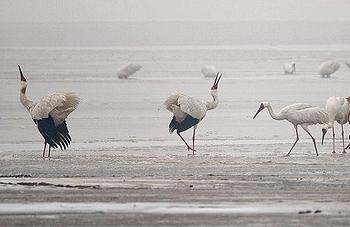
HYDERABAD, India, October 12, 2012 (ENS) – Investing US$80 billion a year would cut the risk of extinction for all threatened species and protect the most important global conservation sites, finds the first study of its kind, issued Thursday by an international team of conservation scientists.
To prevent human-driven extinction and improve the conservation status of all animal and plant species known to be globally threatened would cost just a fraction of the total – no more than US$4.76 billion annually, the study finds.

“The total required is less than 20 percent of annual global consumer spending on soft drinks,” said the paper’s lead author, Donal McCarthy, an environmental economist at the UK-based nonprofit BirdLife International and the Royal Society for the Protection of Birds.
The study was presented in Hyderabad to delegates from 160 governments working on biodiversity conservation at the Conference of the Parties to the Convention on Biological Diversity, CBD. The conference opened Monday and will run through October 19.
Governments are tasked with outlining the next steps needed to implement the Strategic Plan for Biodiversity 2011-2020, agreed two years ago at the CBD conference in Nagoya, Japan.
Following the failure of previous global commitments to even slow the rate of biodiversity loss, in 2010 all governments participating in the Convention on Biological Diversity adopted a new strategic plan – including 20 so-called Aichi Targets to be met by 2020.
The Strategic Plan and its 20 Aichi Biodiversity Targets are the agreed framework for biodiversity work in the United Nations system.
In line with their commitments in Nagoya, over the past two years, countries have been updating their national biodiversity strategies and action plans to achieve the Aichi Targets.

But financing negotiations are still unresolved due to what the study’s authors call “a lack of political will and patchy information on the investments needed.”
The new study contains the first authoritative information on the financial costs of meeting the two Aichi Targets that the authors consider most urgent: saving threatened species and protecting key sites for conservation.
Published in the journal Science, the paper, “Financial Costs of Meeting Two Global Biodiversity Conservation Targets: Current Spending and Unmet Needs,”
was written by a team led by scientists from UK-based BirdLife International and the Royal Society for the Protection of Birds, RSPB, which is the BirdLife affiliate in the UK.
The study uses data for birds, the best known class of organisms, to estimate the costs of meeting conservation targets for all of nature.
According to the Red List of Threatened Species maintained by the International Union for the Conservation of Nature, IUCN, out of the 63,837 species assessed, 19,817 are threatened with extinction.
This figure includes 41 percent of all amphibians, 33 percent of reef building corals, 25 percent of mammals, 13 percent of birds, and 30 percent of conifers.

The authors estimate it would cost between US$880 million and 1.23 billion annually over the next decade to reduce the extinction risk of all globally threatened bird species enough to show improvement by one category on the IUCN Red List of Threatened Species.
That would mean improving a species’ conservation status from Critically Endangered to Endangered, for instance, or from Vulnerable to Least Concern.
Just 12 percent of this funding is currently provided.
“The shortfalls we have identified highlight a clear and urgent need to scale up investment in biodiversity conservation substantially. The total costs are very small relative to the likely costs of inaction,” McCarthy said. “The total is just one to four percent of the net value of ecosystem services being lost annually, for which estimates range from $2 to $6.6 trillion.”
Dr. Stuart Butchart, BirdLife International’s Global Research Coordinator, said, “The total sums may sound large, but these are investments, not bills. “Saving nature makes economic sense because of the payback in terms of services and benefits that people receive in return, from mitigating climate change to pollinating crops.”
The analysis, funded by the Cambridge Conservation Initiative Collaborative Fund for Conservation and Arcadia, provides a sound basis for resolving the discussions among governments on the finance needed to implement the CBD Strategic Plan for Biodiversity up to 2020.

Negotiators are facing the challenge of addressing the current mismatch between the higher resources available in richer countries and the higher conservation needs in biodiversity-rich but financially poor countries.
“Resolving the on-going conservation funding crisis is urgent,” said Butchart. “The longer that investments in conservation are delayed, the more the costs will grow and the greater will be the difficulty of successfully meeting the targets.”
The world’s governments have committed to increasing the coverage of protected areas by 2020, but half of the world’s most important sites for nature are currently unprotected.
“In Nagoya, we agreed the Big Plan with ambitious yet realistic targets to save our planet’s biodiversity,” says Julia Marton-Lefèvre, IUCN Director General. “We need to keep the momentum going. Biodiversity loss continues and has breached safe planetary boundaries. It’s time for a serious check-up on progress we’ve made to turn the Big Plan into Big Action.”
“Two years ago in Nagoya, the world set a framework to achieve the Aichi Biodiversity Targets,” said Braulio Ferriera da Souza Dias, executive secretary of the Convention on Biological Diversity. “Since then we have seen significant progress around the world. This is encouraging but we know that we need to do more in order to realize the ambitions of the Strategic Plan and achieve the Aichi Targets. This will be challenging as it involves short term costs. However, the environmental and social benefits will be realized in the long term. Most of the time, this will simply mean spending existing resources in a different way.”
Copyright Environment News Service (ENS) 2012. All rights reserved.
© 2012, Environment News Service. All rights reserved. Content may be quoted only with proper attribution and a direct link to the original article. Full reproduction is prohibited.
